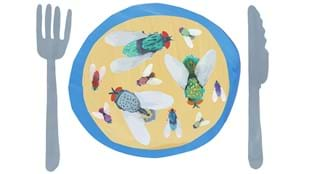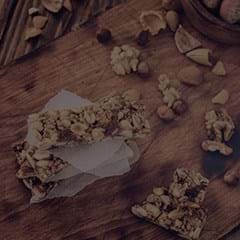What got you so interested in flies?
I got interested in them as an undergrad, when I did some forensic entomology, and saw how useful flies could be in solving crime; you can use DNA to identify the different species of flies, and accurately estimate the minimum time since death. Different species grow at different rates. Blowflies can lay their eggs within minutes of death, so you can use the size of the maggot to estimate how long it has been in the corpse, and assess whether a suspect has an alibi for when the murder occurred.
Now your attentions have focused on the black soldier fly, more specifically black soldier fly larvae. What’s so great about the black soldier fly?
Black soldier flies are getting a lot of attention in both the scientific and agricultural community, because the larvae are eating machines, and can process any sort of organic matter and turn it into this rich source of protein, calcium, essential fats and amino acids. I like to call them the original hipsters, because they only eat organic and they love to recycle. The larvae are 45 percent protein, and what’s great about them is that you don’t have to wait for them to turn into adults to cultivate them as a source of protein. We currently cultivate crickets as a source of protein, but you have to wait for them to go through metamorphosis. With black soldier flies, we just need the larvae.
Your research is looking at the black soldier larvae as an alternative livestock feed, rather than a human food. Why is this important?
We currently use half the world’s usable surface to grow crops like soy and corn to feed the current agricultural animals. Black soldier flies require a fraction of that. They can be grown in smaller warehouses stacked on each other, even in the dark. They don’t require such significant land resources, which means we could use the rest of the land to grow more food for humans, or even return it to nature, which would be fantastic.
Currently eight percent of the world’s water, used by humans, is used for livestock. Insects only require about one percent. And we don’t need to be growing food for these insects; they can be using our waste and converting that into livestock feed, and diverting thousands of tonnes of organic waste from even entering landfill in the process.
There’s been a bit of press in recent years about humans needing to get used to eating insects as a source of protein. Are we likely to our heads around that in the West?
Using insects to feed the world is quite a quirky idea at the moment, but it’s something we’re going to have to face in the next 50 years. In the year 2050 we’re going to be feeding 9.6 billion humans on the same limited land we have today, so we’re going to have to look for alternative ways to feed this growing population. Insects are a great way of keeping up protein consumption, and have been part of the human diet for thousands of years in some parts of the world.
Like where?
It’s quite common in South East Asia. Go to any street stall in Thailand and you’ll see deep fried crickets, and even scorpions and water bugs. They’re quite chill with eating insects. I was at an entomology conference a few years ago where they had rhinoceros beetle chips. They were dehydrated, cheese and bacon flavored, and quite crunchy and very tasty. I bought some protein bars that are made from cricket powder recently in the US; they come in a variety of flavors, like dark chocolate, ginger and lime, peanut butter and chocolate, and were ten percent protein.
We’re developing protein powders for protein shakes, using cricket meal and other insects. There’s cricket pasta available to consumers in the US. Insects are being used in pet food ... we’re starting out small by introducing insects to pet food, and when we become more comfortable with the idea, we’ll start using it in our cooking.
Going back to black soldier fly larvae – do animals like eating it?
It depends on what animal you’re feeding it to. Chickens love it, they actually prefer it to conventional meal. Instead of having to peck through the ground for a few grains at a time, they can eat one plump larvae and be quite satisfied. There’s more nutrition in black fly larvae than traditional meals. Chickens eating it have grown 15 percent larger. But it’s an emerging industry so we need to do more research on what animals enjoy black soldier fly larvae, and if they can get a balanced diet of eating it, or if we have to supplement.
You’ve also suggested that black soldier fly larvae could be used in fish farms?
This really has me excited. A lot of traditional feed for fish comes from dredging and other sustainable forms of getting fishmeal. Some workers in the prawn industry just dredge the bottom of the ocean, grind it up and feed it to prawns, which isn’t sustainable and severely damages the environment. So we could use black soldier fly larvae to feed fish farms instead. The other great thing about black soldier fly larvae is that they eat manure, so we could take the fish waste and feed it to the black soldier fly larvae. It’s a closed cycle. It’s the same with cows; black soldier fly larvae can be grown purely on manure, so we can reduce the waste of the livestock industry and turn it into livestock feed.
Sounds like the black soldier fly is the fly that keeps on giving?
It is! Some trials in Costa Rica showed they can reduce household waste by 75 percent by feeding it to black soldier flies, therefore diverting thousands of household waste from entering landfill, and at the same time turning it into a commercially viable product. The other great potential use is biodiesel as a by-product, by decanting the oil from the larvae in the process of harvesting them for animal feed.
If we were to fast forward 20 years, do you really think we’ll have warehouses growing black soldier fly larvae for animal feed?
It’s already happening, right here in Canberra, as well as the US and South Africa. This is on the cusp of going global. People are realizing how important this could be. Insects will be the next superfood if we let them.

Dr Lessard now works as a Postdoctoral Fellow at the Australian National Insect Collection at CSIRO in Canberra, where he researches the evolution of soldier flies, including ‘Hermetia illucens’. He has described over 18 species of flies new to science. To help generate buzz around taxonomy, the science of naming and classifying organisms, he described a horse fly with a golden abdomen after the performer Beyoncé, ‘Plinthina beyonceae’, sparking an international conversation about the importance of flies.







